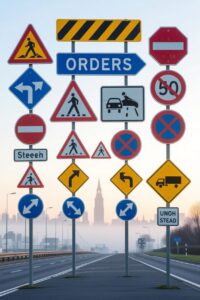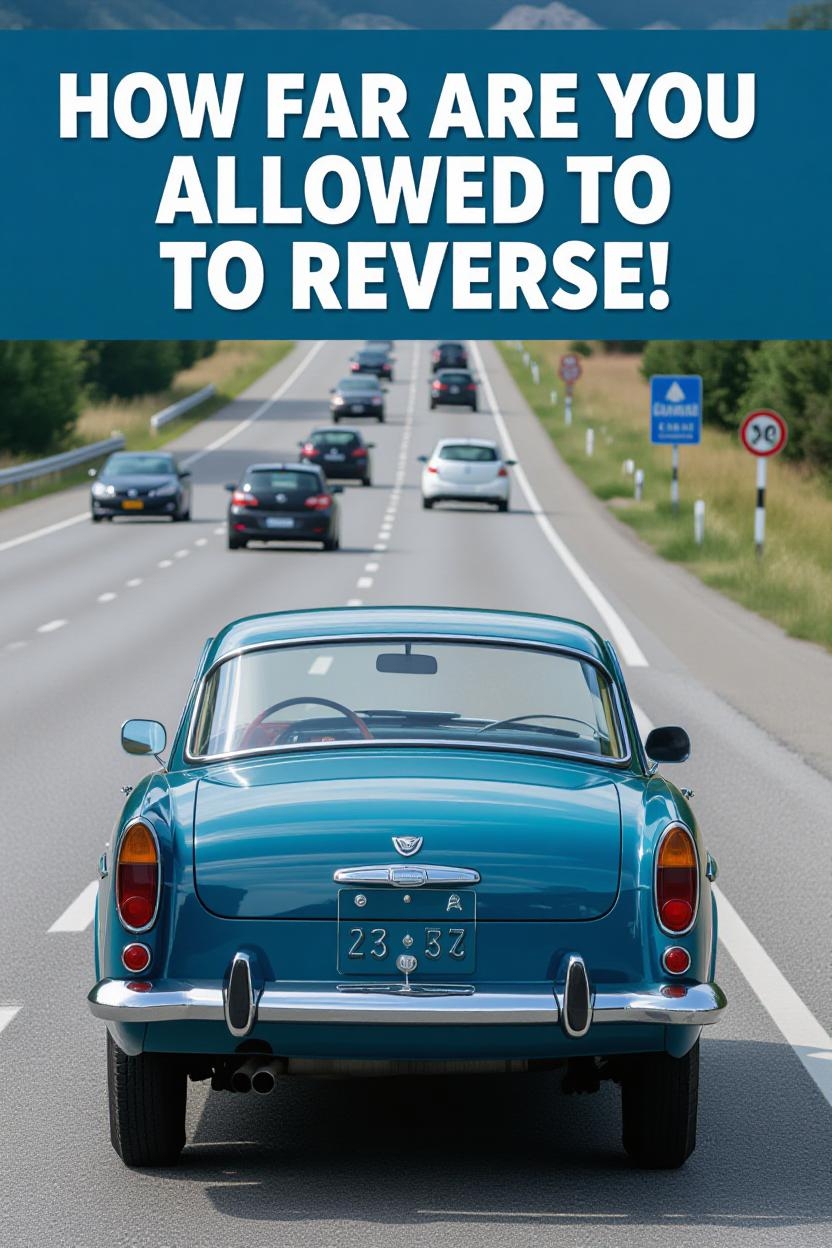What Shape Are Traffic Signs Giving Orders
Traffic signs that give orders—also known as regulatory signs—are specially designed with specific shapes and colors to convey authority and grab attention instantly. Here’s an explanation that goes beyond what you’ll usually find in blogs:
What Shape Are Traffic Signs Giving Orders?
Shape of Traffic signs that give orders are predominantly circular in shape, a design choice rooted in their need to convey clear, immediate instructions to drivers.
This applies to signs enforcing prohibitions (e.g., “No Entry,” “No Left Turn“) or mandatory actions (e.g., “Keep Right,” “Minimum Speed“).
The circular shape is distinct from other traffic signs, like triangular warning signs or rectangular information signs, because it leverages visual psychology: circles are easily recognizable and demand attention due to their symmetry and lack of sharp edges.
- Red-bordered circles typically signify prohibitions, such as “No Parking” or “No Overtaking.” The red border acts as a visual stop signal, reinforcing the restrictive nature of the instruction.
- Blue circles indicate mandatory actions, like “Turn Right” or “Bicycles Only,” guiding drivers toward required behavior with a calmer, directive tone.
This circular convention, widely used in regions like Europe and the UK, ensures uniformity and quick recognition, reducing driver confusion.
Unlike warning signs (triangles, which signal potential hazards) or informational signs (rectangles/squares, which provide guidance like directions or parking details), the circle’s simplicity prioritizes compliance.
Variations exist globally—some countries may use slight adaptations (e.g., octagonal “Stop” signs in the US)—but the circular shape for orders remains a near-universal standard where adopted.
Local traffic regulations should always be consulted for specific differences.
Why Different Traffic Signs Giving Orders Shapes Matter More Than Color?
The shape of traffic signs giving orders matters more than color because shape is the primary visual cue for rapid recognition and comprehension, especially in high-speed or low-visibility driving conditions. Here’s why shape takes precedence, with reasoning distinct:
- Instant Visual Processing: Human brains process shapes faster than colors due to the simplicity of geometric forms. Circular signs (used for orders like “No Entry” or “Turn Right”) stand out immediately against the environment, allowing drivers to identify the sign’s purpose—mandatory or prohibitive—before discerning specific details. This is critical at high speeds or in split-second decision-making scenarios.
- Shape Consistency Across Contexts: Shapes are universally standardized in many regions (e.g., circular for orders in Europe, UK, and beyond), ensuring drivers recognize the sign’s intent regardless of language, lighting, or weather. For example, a faded red circle’s shape still conveys “prohibition” even if the color is less distinct, whereas color alone (e.g., red without a circular shape) could be mistaken for other sign types.
- Psychological Impact of Geometry: Circles, used for order-giving signs, lack sharp angles, making them visually distinct from triangular warning signs (which signal danger) or rectangular informational signs. This geometric clarity reduces cognitive load, helping drivers instantly categorize the sign as an instruction rather than a warning or guidance.
- Color as Secondary Reinforcement: While colors like red (prohibition) or blue (mandatory) enhance meaning, they are less reliable due to potential colorblindness, fading, or poor visibility (e.g., at night or in fog). Shape remains discernible under these conditions, ensuring the sign’s intent is clear. For instance, a colorblind driver can still recognize a circular “No Parking” sign by its shape alone.
- Global Standardization: Shapes are more consistently applied across countries for order-giving signs than colors. For example, the US uses an octagonal “Stop” sign (a unique shape for a critical order), while circular signs dominate in Europe. This shape-based consistency aids international drivers, whereas color schemes may vary or be less distinct.
- Functional Hierarchy: Shapes establish a hierarchy of urgency. Circles for orders demand compliance, triangles for warnings signal caution, and rectangles for information provide context. This hierarchy guides driver behavior more effectively than color, which primarily reinforces the message.
List Of Traffic Signs Giving Orders Shapes, Symbols And Their Meanings:

Below is a list of common traffic signs giving orders, their shapes, and their meanings, based on widely recognized standards (with a focus on systems like those in the UK and Europe, unless otherwise noted). This list is derived from standard traffic sign conventions.
✓ Prohibitory Traffic Signs (Circular with Red Border)
These signs indicate actions that are not allowed.
1. No Entry
- Shape: Circular
- Description: Red circle with a white horizontal bar, prohibiting entry to all vehicles.
2. No Vehicles
- Shape: Circular
- Description: Red circle with a white background, banning all vehicles.
3. No Left Turn
- Shape: Circular
- Description: Red circle with a left arrow, prohibiting left turns.
4. No Right Turn
- Shape: Circular
- Description: Red circle with a right arrow, prohibiting right turns.
5. No U-Turn
- Shape: Circular
- Description: Red circle with a U-shaped arrow, prohibiting U-turns.
6. No Overtaking
- Shape: Circular
- Description: Red circle with two arrows (one up, one down), prohibiting overtaking.
7. No Parking
- Shape: Circular
- Description: Red circle with a blue background and a single red diagonal line, indicating no parking.
8. No Stopping
- Shape: Circular
- Description: Red circle with a blue background and two red diagonal lines (forming an X), indicating no stopping.
9. Speed Limit
- Shape: Circular
- Description: Red circle with a number indicating the maximum speed (e.g., “30” for 30 km/h or mph).
10. End of Restriction
- Shape: Circular
- Description: White or gray circle with a diagonal line, indicating the end of a previous restriction (e.g., speed limit or no overtaking).
Mandatory Traffic Signs Giving Orders (Circular with Blue Background)
These signs indicate actions that must be taken.
1. Go Straight
- Shape: Circular
- Description: Blue circle with a white straight arrow, requiring vehicles to proceed straight.
2. Turn Left
- Shape: Circular
- Description: Blue circle with a white left arrow, requiring vehicles to turn left.
3. Turn Right
- Shape: Circular
- Description: Blue circle with a white right arrow, requiring vehicles to turn right.
4. Keep Left
- Shape: Circular
- Description: Blue circle with a white left arrow or symbol, requiring vehicles to pass to the left of an obstacle.
5. Keep Right
- Shape: Circular
- Description: Blue circle with a white right arrow or symbol, requiring vehicles to pass to the right.
6. Bicycles Only
- Shape: Circular
- Description: Blue circle with a white bicycle symbol, restricting the road to bicycles only.
7. Pedestrians Only
- Shape: Circular
- Description: Blue circle with a white pedestrian symbol, restricting the path to pedestrians only.
8. Minimum Speed
- Shape: Circular
- Description: Blue circle with a white number, indicating the minimum speed required.
Exceptions To Circular Shape Traffic Signs Giving Orders:
While circular signs dominate for orders in many countries, some regions use different shapes for specific order-giving signs and if you aren’t aware yet, then check out our list of diamond shaped traffic signs and who should obey them:
1. Stop Sign
- Shape: Octagonal (common in the US, Canada, and some other countries)
- Description: Red with white letters spelling “STOP,” requiring vehicles to come to a complete stop. The unique octagonal shape ensures instant recognition.
2. Yield (Give Way)
- Shape: Inverted Triangle (common in the US, Canada, and others) or Circular (in some European countries)
- Description: Often a white triangle with a red border (or a circular sign in some regions), requiring drivers to yield to other traffic.
3. Priority Road
- Shape: Diamond (in some countries) or Circular (in others)
- Description: Indicates a road with priority over others, often a yellow or white diamond or a circular sign with a specific symbol.
What You Should Know About Traffic Signs Giving Orders?
- Circular Dominance: The circular shape is the standard for order-giving signs in most countries following the Vienna Convention on Road Signs and Signals (e.g., Europe, UK, much of Asia). It ensures quick recognition and distinguishes orders from warnings (triangular) or information (rectangular/square).
- Regional Variations: The US and some other countries use unique shapes like octagons for “Stop” signs to emphasize critical instructions. Always check local regulations for specific shapes and meanings.
- Color as Secondary: While red (prohibition) and blue (mandatory) are common, the circular shape is the primary identifier, as it remains recognizable in poor visibility or for colorblind drivers.
Summary
Traffic signs giving orders—such as those mandating actions like speed limits, no turns, or required directions—are primarily circular in shape to ensure rapid recognition and compliance by drivers.

This shape distinguishes them from other sign types, like triangles for warnings or rectangles for information, emphasizing their authoritative role in road safety.
Red-bordered circles typically prohibit actions, while blue ones enforce mandatory behaviors, though exceptions like octagonal stop signs highlight regional variations for critical commands.
Ultimately, these designs prioritize visibility and psychological impact over mere color, reducing confusion and enhancing overall traffic flow in diverse driving conditions.


